Unfortunately, I wasn’t able to find any native speakers of Ancient Greek to discuss slang words, but in our readings we’ve examined some works by Aristophanes who is known for his use of more colloquial language. So when I was talking to my professor about our sources of slang from Ancient Greece, she directed me to some specific terms from Aristophanes’ comedies and the terms I’ll be examining more closely are: τᾶν, σοφιστής, and a passage from The Akharnians.
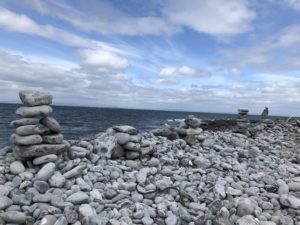 Since I took breaks from studying Ancient Greek by traveling around the Irish countryside, I thought that I’d share some of my favorite pictures of different places throughout this post. So here is the coastline of Inishmore, one of the Aran Islands off the Cliffs of Moher
Since I took breaks from studying Ancient Greek by traveling around the Irish countryside, I thought that I’d share some of my favorite pictures of different places throughout this post. So here is the coastline of Inishmore, one of the Aran Islands off the Cliffs of Moher
τᾶν is a vocative, or direct address, meaning sir or gentlemen. The most well-known use of the vocative (in my opinion) comes from Shakespeare when Julius Caesar says “Et tu, Brute,” Brute is the vocative form of Brutus. But τᾶν is indeclinable, meaning it doesn’t serve any purpose outside of addressing someone and it has a nuanced meaning, as the textbook notes that it is condescendingly used. In context, two characters of Aristophanes’ Birds, Dikaiopolis and the rhapsode, or a reciter of Homeric poetry, are having a conversation about Pericles, the Athenian general at the beginning of the Peloponnesian War, and they hold very different opinions about. The rhapsode is of the mind that Pericles was the best thing to happen to Athens, while Dikaiopolis blames Pericles for forcing him off of his farm and for the death of his entire family in the city. But the rhapsode doesn’t know this yet, so when he says, “What are you saying, sir?” he is incredulous.
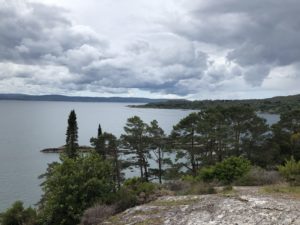 This was taken on Garnish Island, off the coast of Glenfarriff in Co. Cork
This was taken on Garnish Island, off the coast of Glenfarriff in Co. Cork
On a side note, the textbook my class uses is British and for the most part, I don’t see any real difference between British and American English when it comes to studying Ancient Greeks. We don’t talk about soccer/football or fries/chips and grammatically, I couldn’t tell the difference between British and American English before this course. But now I know that British English uses shall and will differently than American English to denote a threat or intention, as well as some other aspects of grammar. But the exact translation of τᾶν is “my dear chap” and that is something that makes the textbook uniquely British.
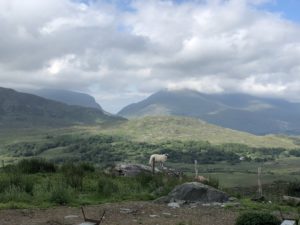 Molls Gap in Kenmare, on a tour of the Ring of Kerry
Molls Gap in Kenmare, on a tour of the Ring of Kerry
σοφιστής – This is an interesting word because a sophist was a tutor, typically of subjects such as rhetoric, philosophy, or politics, for young intellectuals of the wealthy upper class in 4th and 5th BC Athens. Socrates, according to Plato, was not a sophist, as he did not accept payment and disputed with sophists of that day. Yet in reading Clouds by Aristophanes, we meet the character, more a caricature, of Socrates and other sophists who are depicted as airheads (they have their head in the clouds and no grasp on reality) and thieves who take money from their students and teach them nonsense. Sophists in Athens really were highly criticized for accepting payment for their teachings, we know this from Plato’s account of Socrates’s trial and Plato is credited with defining the modern term sophist to mean a teacher of deception and false logic. I haven’t read Plato’s Sophist, so I can’t give his full account on the differences between a sophist, a philosopher, and a statesman. But Aristophanes uses the word, σοφιστής, in its more colloquial meaning and gives these philosophers the appearance of swindlers and cheaters, and makes Socrates their leader, which was used against him at his trial for corrupting the youth of Athens.
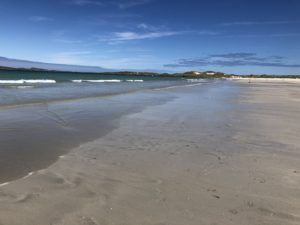 The coastline at Carrickfinn Beach, right next to the Donegal Airport, which was voted the most scenic airport in the world
The coastline at Carrickfinn Beach, right next to the Donegal Airport, which was voted the most scenic airport in the world
The word σοφιστής is not an inappropriate, unsuitable for innocent ears, per se, but one must consider the implication of calling someone a sophist, whether they simply mean a teacher or a deceitful one. In the context of calling Socrates as sophist as compared to calling Gorgias, one of the founders of sophistry, the same would be very different situations. Regardless of a positive or negative view on sophistry, Gorgias was a sophist and calling him as such is a statement of fact. Whether to criticize or praise him for his skills and work would depend on who was speaking and to whom.
 This is a picture of the Lake Isle of Innisfree, from the poem by W.B. Yeats, on Lake Gill by Sligo
This is a picture of the Lake Isle of Innisfree, from the poem by W.B. Yeats, on Lake Gill by Sligo
Coming to the last example, I’ll admit that when I first read colloquial/slang words, my mind immediately went to curses. Then I considered in which situations are curse words appropriate to use? Not school assignments, that’s for sure. Nonetheless, I thought that a curse would make for an interesting examination of language. In this passage from The Akharnians, the chorus is cursing Lamachus, who was an Athenian general in the Peloponnesian War, and subsequently mocked by Aristophanes.
“τοῦτο μὲν αὐτῷ κακὸν ἕν, κᾆθ᾽ ἕτερον νυκτερινὸν γένοιτο.
ἠπιαλῶν γὰρ οἴκαδ᾽ ἐξ ἱππασίας βαδίζων,
εἶτα κατάξειέ τις αὐτοῦ μεθύων τῆς κεφαλῆς Ὀρέστης
μαινόμενος: ὁ δὲ λίθον βαλεῖν
βουλόμενος ἐν σκότῳ λάβοι
τῇ χειρὶ πέλεθον ἀρτίως κεχεσμένον:
ἐπᾴξειεν δ᾽ ἔχων
τὸν μάρμαρον, κἄπειθ᾽ ἁμαρτὼν
βάλοι Κρατῖνον.” (Aristophanes, The Akharnians, ll.1164-1174)
As for the English translation,
“That’s one curse for him; and here’s another, to happen to him in the night.
As he walks home shivering after galloping his horse,
I hope some drunkard— mad Orestes! —
knocks him on the head; and when he wants to grab a stone
I hope in the darkness he grabs in his hand a fresh-shat turd,
and holding that glittering missile
let him charge at his foe, then miss him
and hit Cratinus!”
Translation from: https://www.loebclassics.com/view/aristophanes-acharnians/1998/pb_LCL178.209.xml
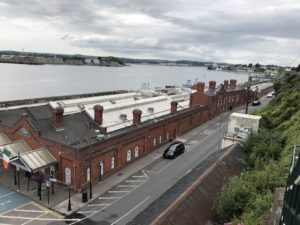 The train station and Cobh Heritage Center, Co. Cork
The train station and Cobh Heritage Center, Co. Cork
As a note, Orestes was the son of Agamemnon and Clytemnestra, a figure from Euripides’s plays, the Oresteia trilogy, and serves as a metaphor for madness and aggression, while Cratinus was the name of a rival of Aristophanes. In looking at different translations of this passage, I was struck by the variety of nuances I was able to find. I chose this translation because it stuck to the original Greek as closely as possible, instead of aiming for the gist of the meaning and getting lost in euphemisms. The meaning is clear as there’s no double entendre or beating around the bush, and Aristophanes is crass. Instead of using curse words, the chorus members are trying to curse Lamachus. The one curse for him that proceeds this one is that sometime when he’s very hungry and just about to take a bite of his food that a dog will come and steal it from him.
 A regatta in Kinsale, Co. Cork
A regatta in Kinsale, Co. Cork
All three of these examples of slang or colloquialisms come from Aristophanes’s plays and to understand how or why they’re used, I will explain a bit about Greek drama. Comedy is the surviving source for some of the closest looks into the daily life of 5th century BC Athenians. The theater was a time and place where all people, regardless of social class, age, gender, and so forth, let loose and social bearings became unmoored. The comic poets took everyday situations, archetypes of society, and exaggerated them, or turned them on their head. Aristophanes in particular was known for his accuracy in the portrayal of Athenian life, and was known as the Father of Comedy. Personally, I liked reading his works because translating dialogue went much faster than prose. His works were meant as pleasure for the people, not to impress them with displays of oratory prowess. These comedies were written for the popular crowd, Athenians of every age and status, and specifically written to engage with the audience, with the chorus of a play often breaking the fourth wall to directly address the crowd. Greek comedy explored taboo subjects, political and religious tensions, and used language that wasn’t allowed in everyday interactions or other surviving works of Ancient Greek, such as oratorical speeches or epic poetry.
 Since I took breaks from studying Ancient Greek by traveling around the Irish countryside, I thought that I’d share some of my favorite pictures of different places throughout this post. So here is the coastline of Inishmore, one of the Aran Islands off the Cliffs of Moher
Since I took breaks from studying Ancient Greek by traveling around the Irish countryside, I thought that I’d share some of my favorite pictures of different places throughout this post. So here is the coastline of Inishmore, one of the Aran Islands off the Cliffs of Moher This was taken on Garnish Island, off the coast of Glenfarriff in Co. Cork
This was taken on Garnish Island, off the coast of Glenfarriff in Co. Cork Molls Gap in Kenmare, on a tour of the Ring of Kerry
Molls Gap in Kenmare, on a tour of the Ring of Kerry The coastline at Carrickfinn Beach, right next to the Donegal Airport, which was voted the most scenic airport in the world
The coastline at Carrickfinn Beach, right next to the Donegal Airport, which was voted the most scenic airport in the world This is a picture of the Lake Isle of Innisfree, from the poem by W.B. Yeats, on Lake Gill by Sligo
This is a picture of the Lake Isle of Innisfree, from the poem by W.B. Yeats, on Lake Gill by Sligo The train station and Cobh Heritage Center, Co. Cork
The train station and Cobh Heritage Center, Co. Cork A regatta in Kinsale, Co. Cork
A regatta in Kinsale, Co. Cork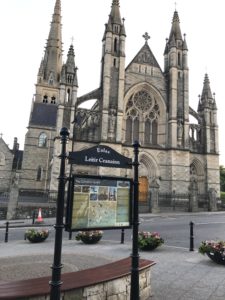
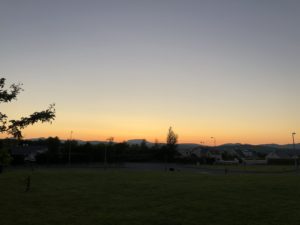 The Cathedral of St. Eunan and St. Columba in Letterkenny and the sunset from the front door with Benbulben in the skyline
The Cathedral of St. Eunan and St. Columba in Letterkenny and the sunset from the front door with Benbulben in the skyline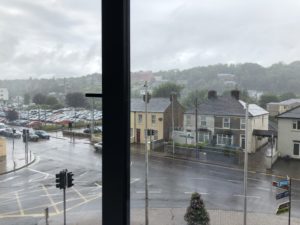
 The weather in Cork was pretty consistent, with not too many days like the first, but these pictures were taken nine hours apart
The weather in Cork was pretty consistent, with not too many days like the first, but these pictures were taken nine hours apart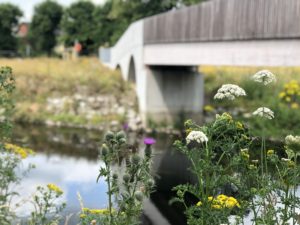
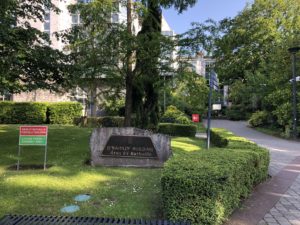 Some flowers next to the bridge I crossed to get to campus, and the sign for the O’Rahilly Building, where we learned Ancient Greek
Some flowers next to the bridge I crossed to get to campus, and the sign for the O’Rahilly Building, where we learned Ancient Greek
 The view of St. Finnbarre’s Cathedral from the top of Elizabeth Fort and one of the paintings on masculinity and media in Irish culture.
The view of St. Finnbarre’s Cathedral from the top of Elizabeth Fort and one of the paintings on masculinity and media in Irish culture. Me, standing outside of the restaurant named after Enya’s father, who just passed away in 2018
Me, standing outside of the restaurant named after Enya’s father, who just passed away in 2018 The Cork Public Museum is in Fitzgerald Park, just beside this water feature
The Cork Public Museum is in Fitzgerald Park, just beside this water feature On a non-jazz note, I was able to see a band that I enjoy after they’ve spent the last five years on hiatus
On a non-jazz note, I was able to see a band that I enjoy after they’ve spent the last five years on hiatus From outside the Butter Museum
From outside the Butter Museum
 Our demonstrator churning and draining the butter
Our demonstrator churning and draining the butter The remains of the Cork Butter Exchange
The remains of the Cork Butter Exchange Bog butter
Bog butter